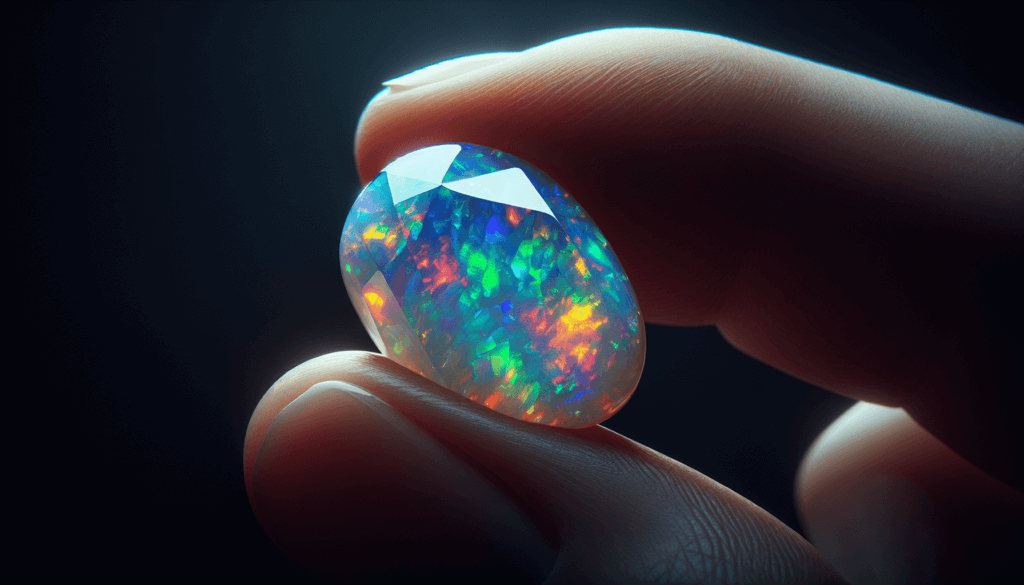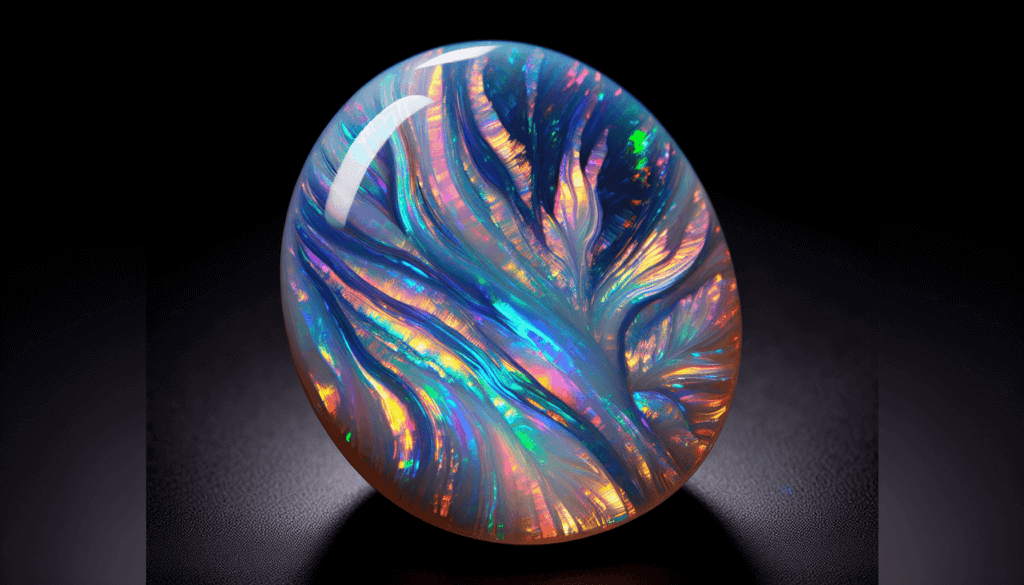Unearth the radiant secrets that lie within opals, the magical gemstones known for their enchanting play of colors. You might just find yourself spellbound as you explore and unravel the unique characteristics and formation processes of these fascinating jewels. In the article “What Makes Opal Unique?”, you’ll discover an in-depth look into the opal’s distinctive physical and optical qualities, its mesmerizing color spectrum called “play-of-color”, as well as its supreme relevance in cultural and historical contexts. Hold onto your fascination as you step into the dazzling world of opals.

Composition of Opal
Opal is indeed a unique gemstone. Its distinctive nature lies in its chemical and physical properties. Let’s unearth these characteristics that add to its charm and allure.
Nature and Characteristic of Silica Spheres
Your enigmatic opal is made up of microscopic silica spheres that are oriented in a specific lattice or array, resulting in a three-dimensional structure. It’s this compact structure that provides opal its hardness and its ability to resist wear. Different types of opal have slight variations in the alignment and size of these spheres, creating the diversity in opal varieties.
How Water Content Affects Opal
Water content plays an integral part in the opal’s make-up. Most opals contain about 5-10% of water, which influences their toughness and color vibrancy. Too much water can make the opal brittle and susceptible to damage, while too little can result in loss of color intensity.
Role of Trace Elements in Opal
Trace elements are another factor that contribute to the unique characteristics of opal. These elements are occasionally interspersed among the silica spheres, introducing color and other visual effects. For instance, iron and carbon may impart a greenish hue or darken the body color, respectively.
Varieties of Opal
One of the fascinating aspects of opal is its variety. From the fiery reds of the fire opal to the deep, dark hues of the black opal, this gemstone never fails to captivate.
Characteristics of Precious Opal
Precious opal, also known as noble opal, is renowned for its remarkable play-of-color, where a rainbow of hues flickers and dances across the stone. This play-of-color comes from the interaction of light with the silica spheres in the opal’s structure.
Properties of Common Opal
Unlike precious opal, common opal, also known as potch, does not exhibit any play-of-color. It can come in a variety of base colors including white, gray, red, orange and black, making it versatile for use in jewelry.
Understanding Fire Opal
Fire opal is renowned for its stunning body color that ranges from yellow to a fiery red. This opal, though it may not always display play-of-color, is highly sought after for its vibrant, warm hues that are reminiscent of sunset.
Explaining Boulder Opal
Boulder opal, as its name suggests, is found within ironstone boulders. This variety of opal has the parent rock naturally backing the veins of opal, giving it durability and an earthy, rustic appearance.
What is Crystal Opal
Crystal opal is a transparent to semi-transparent variety of precious opal, which allows light to pass through, enhancing its play-of-color.
Detailing Black Opal
Black opal, the rarest and most valuable of all opals, boasts a dark body color which creates a stunning contrast with its vibrant play-of-color.
Insights about White Opal
White opal, with its light body color, provides a softer and more subtle play-of-color. It’s the perfect stone for those who prefer a gentle sparkle over bold flashes.

Opal’s Unique Play of Color
The play-of-color exhibited by opal is one of its most entrancing features. Let’s delve into the science behind this spectral delight.
Explanation of Diffraction and Interference
The play-of-color is down to diffraction and interference of light. As light enters the opal’s structure, it interacts with the silica spheres, breaking up the light into its individual color components. This is known as diffraction. The diffracted light then interferes constructively or destructively, intensifying or reducing specific colors.
Spatial Arrangement of Silica Spheres and Color Display
The color display depends on the size and arrangement of these silica spheres. Larger spheres result in the display of reds and oranges, while smaller spheres produce blues and violets. The more orderly the arrangement, the more vivid the play-of-color.
Formation Process of Opal
The process of opal formation is a testament to nature’s incredible capacity to generate beauty from simple constituents.
Role of Silica Gel
Opal begins its journey as a silica gel that seeps into crevices in rocks. Over time, this gel gradually hardens and, aided by nature’s pressure and temperature conditions, forms opal.
Effect of Weathering and Erosion
Both weathering and erosion play significant roles in the formation of opal. Weathering breaks down rock, releasing the silica needed for opal formation. Erosion, on the other hand, transports this silica to areas where opal can form.
Natural Processes Transforming Decaying Organic Matter into Opal
Sometimes, organic matter also contributes to opal formation. Decaying shells, bones, and wood can leave spaces within rocks that become filled with opal, forming opalized fossils which depict the remnants of ancient life in sparkling form.

Distribution and Sources of Opal
Opal can be found around the globe, with each location imparting distinctive qualities to the gemstone formed there.
Opal Mines in Australia
Australia is the leading provider of opal, producing a staggering 95% of the world’s supply. The country is renowned for its fine quality black and white opal, as well as the unique boulder opal found in Queensland.
Opal Deposits in Ethiopia
Ethiopia has become a significant source of opal since the discovery of deposits in the early 1990s. Ethiopian opal is often characterized by its bright play-of-color against a clear, white or brown body color.
Mexican Fire Opals
Mexico is famous for its fire opals, which display intense reds, oranges, and yellows, bringing to mind the colours of a sunset or a flickering fire.
Other notable locations and their characteristics
Other notable sources of opal include Brazil, Nevada in the U.S., and Slovakia. Each of these locations produces opal with unique characteristics, adding to the stone’s diversity.
Opal in History and Folklore
Opal has a long history and has been entwined with various cultures and literatures, adding yet another layer of intrigue to this captivating gemstone.
Opal in Ancient Cultures
In ancient times, opal was cherished for its breathtaking play-of-color, leading it to be associated with magical properties. The Romans, for instance, believed it to be the most powerful and valuable gemstone because it contained the colors of all other gemstones.
Meaning of Opal in Aboriginal Australian Culture
In Aboriginal Australian culture, opal is deeply intertwined with their creation mythology, symbolizing their ancestral being’s footprints on Earth. Many opal sites are considered sacred by Indigenous communities.
Opal Symbolism in European Literature
In European literature, opal was often used as a symbol of shifting emotions and the fleeting nature of beauty, encapsulating the stone’s ever-changing play-of-color.
Valuing and Pricing Opal
Evaluating opal can be a complex task due to its diversity in colors, types, and qualities.
Factors that Influence Opal’s Price
Factors contributing to the value of an opal include its type, color, pattern, size and transparency. Preciousness, brilliance and the range of colors displayed also play significant roles in determining the opal’s worth.
Understanding the difference between commercial and precious opals
Commercial opals may not exhibit the full spectrum of colors or the high brilliance often found in precious opals. This difference makes precious opals more expensive than their commercial counterparts.
Impact of Size, Shape and Pattern on Opal’s Worth
The size, shape and pattern of an opal are also crucial in its valuation. Larger stones are usually more desirable, and irregularly shaped opals may be less valuable than those with well-defined shapes.
Opal and its Metaphysical Properties
Opal has been imbued with various metaphysical properties throughout history, adding to its allure.
Beliefs about Opal’s Healing Abilities
Opal has been reputed to have healing abilities, often associated with emotional healing, personal clarity, and boosting the immune system.
Opal as a Birthstone
With its numerous color displays, opal fittingly represents the birthstone for October, echoing the mesmerizing colors of the autumn season.
Opal’s Association with Energy and Psychic Abilities
Many believe that opal can help to amplify one’s traits and characteristics, stimulate originality and creativity, and encourage an interest in the arts. It’s even considered to enhance psychic abilities for some.
Care and Maintenance of Opal Jewelry
Like any gemstone, taking care of your opal is crucial to ensure its long-lasting beauty.
How to Clean Opal Jewelry
To clean opal jewelry, just use lukewarm water, mild soap, and a soft cloth. Opals are sensitive to heat and harsh chemicals, which could damage them.
Proper Storage of Opals
It’s best to store opals separately from other harder gemstones to prevent scratches. And remember, opals love moisture, so avoid storing them in dry or hot areas.
Preventing Damage to Opal
Avoid wearing your opal jewelry while doing strenuous activities as opals can be damaged by direct blows. Also, preserve the brilliance of your opal by keeping it away from excessive heat and sudden temperature changes.
Imitations and Synthetic Opals
Spotting imitation and synthetic opals can indeed be challenging, but it’s a necessary skill for any opal enthusiast.
How to Identify Fake Opals
Artificially manufactured opals often exhibit uniform coloring and pattern which is rare in natural opals. So, if the play-of-color seems too perfect, it might be an imitation.
Differences between Natural and Synthetic Opals
While synthetic opals are made from the same silica and water as natural ones, they are created in a lab under controlled conditions. This results in a regular pattern and homogeneous color play.
Understanding treated opals and their value
Treated opals undergo processes to enhance their play-of-color or durability. Although these opals are often more attractive, they may not hold the same value as naturally formed untreated opals.
Bringing together science, history, culture and beauty, it’s no wonder that opal is a gemstone like no other. With its variety, play-of-color and fascinating origins, every piece of opal carries with it a little magic from the heart of our Earth. Whether in a pendant, a ring, or a museum display, opal will always invite its observers into an admiration of its unique spectacle of effervescent colors.



